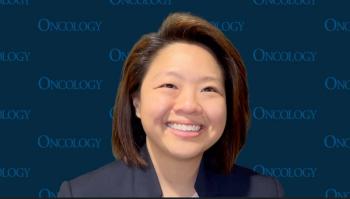
Belantamab Mafodotin Combo Yields PFS Benefit in R/R Multiple Myeloma
Results from the phase 3 DREAMM-7 trial highlighted an efficacy benefit with belantamab mafodotin plus bortezomib and dexamethasone in patients with relapsed/refractory multiple myeloma.
A statistically significant progression-free survival (PFS) benefit was observed when belantamab mafodotin-blmf (Blenrep) plus bortezomib (Velcade) and dexamethasone (BVd) was used to treat patients with relapsed/refractory multiple myeloma, according to results from the phase 3 DREAMM-7 trial (NCT04246047) presented at an American Society of Clinical Oncology plenary session.
The median PFS in the BVd arm was 36.6 months (95% CI, 28.4-not reached [NR]) compared with 13.4 months (95% CI, 11.1-17.5) in the daratumumab (Darzalex), bortezomib, and dexamethasone (DVd) arm (HR, 0.41; 95% CI, 0.31-0.53; P <.00001). At 18 months, the PFS rates were 69% vs 43% in each arm, respectively.
“The DREAMM-7 findings demonstrate that BVd significantly improved outcomes for patients with relapsed or refractory multiple myeloma over the daratumumab regimen while also having a manageable safety profile. With newly diagnosed [patients with] multiple myeloma increasingly receiving triplet and quadruplet therapy combinations, there is a need for treatment options with differing mechanisms of action after first relapse. These results support BVd triplet therapy as a potential new standard of care option for these patients given the magnitude of benefit seen in [PFS] and strong trend in overall survival [OS],” lead study investigator María-Victoria Mateos, MD, PhD, Head of Myeloma and Clinical Trials Unit in the Haematology Department and a professor of Medicine at the University of Salamanca, Spain said in a written statement to CancerNetwork®.
Patients were recruited between May 7, 2020, and June 28, 2021, and randomly assigned 1:1 to one of 2 arms. During cycles 1 to 8 In the BVd arm, patients received belantamab intravenously at 2.5 mg/kg every 3 weeks plus 1.3 mg/m2 of subcutaneous bortezomib on days 1, 4, 8, and 11 plus 20 mg of dexamethasone on the day of and day after bortezomib. For cycles 9 or more, patients received belantamab intravenously at 2.5 mg/kg every 3 weeks.
In the DVd arm, daratumumab was given intravenously at 16 mg/kg from cycles 1 to 3 every week and cycles 4 to 8 every 3 weeks plus matched bortezomib and dexamethasone. For cycles 9 or more, daratumumab was given intravenously at 16 mg/kg every 4 weeks.
The follow-up for PFS occurred every 3 weeks, and the follow-up for OS occurred every 12 weeks. The primary end point was PFS, and secondary end points included OS, duration of response (DOR), and minimal residual disease (MRD).
A total of 494 patients were enrolled in either the BVd arm (n = 243) or the DVd arm (n = 251). Currently, 33% of patients are still receiving belantamab compared with 20% receiving daratumumab. The median follow-up was 28.2 months.
In the intent-to-treat population, the median age was 65.0 years in the BVd arm and 64.0 years in the DVd arm, with 53% vs 57% being male, and 96% vs 96% having an ECOG performance score of 0 or 1. Extramedullary disease was not observed in 95% of patients in the BVd arm vs 90% in the DVd arm.
Most patients had received 1 prior line of therapy (51% vs 50%) followed by 2 or 3 (36% vs 39%) or 4 or more (12% vs 11%) between the BVd and DVd arms, respectively. In both arms, prior bortezomib was given (86% vs 84%), and approximately a third of patients were refractory to lenalidomide (33% vs 35%).
The median OS was NR in the BVd and DVd arms (HR, 0.57; 95% CI, 0.4-0.8; P = .00049). At 12 months, the OS rate was 87% vs 81% in the BVd arm and DVd arm, and at 18 months, it was 84% vs 73%.
The objective response rate was 82.7% (95% CI, 77.4%-87.3%) vs 71.3% (95% CI, 65.3%-76.8%) in each respective arm. Additional response rates between arms included a stringent complete response (14% vs 5.2%), complete response (20.6% vs 12.0%), very good partial response (31.3% vs 29.1%), and partial response (16.9% vs 25.1%).
In the BVd arm, an MRD negativity rate of 38.7% (95% CI, 32.5%-45.1%) was observed compared with 17.1% (95% CI, 12.7%-22.4%) in the DVd arm.
A median DOR of 35.6 months (95% CI, 30.5-NR) occurred in the BVd arm compared with 17.8 months (95% CI, 13.8-23.6) in the DVd arm. At 18 months, ongoing responses were reported in 76% vs 49%, respectively.
Grade 3/4 adverse effects (AEs) occurred in 95% of patients in the BVd arm vs 76% in the DVd arm. Treatment discontinuation due to AEs occurred in 31% vs 19%, dose reductions occurred in 75% vs 59%, dose interruptions or delays in 94% vs 75%, any serious AEs in 50% vs 37%, and fatal serious AEs in 10% vs 8% of patients in the BVd and DVd arms, respectively.
Additional grade 3 or higher AEs included thrombocytopenia (55% vs 35%), anemia (8% vs 10%), neutropenia (12% vs 6%), and pneumonia (12% vs 4%) between both treatment arms.
Occular AEs of grade 3 or higher occurred in 34% vs 3% of patients in the BVd and DVd arms, respectively. Specific AEs included blurred visions (22% vs less than 1%), dry eye (7% vs 0%), eye irritation (5% vs 0%), and visual impairment (5% vs less than 1%). Additionally, of the patients who experienced an ocular event, 44% had a dose reduction, 78% had delays or interruptions, and 9% discontinued treatment.
Reference
Mateos MV, Robak P, Hus M, et al. Results from the randomized phase III DREAMM-7 study of belantamab mafodotin (belamaf) + bortezomib, and dexamethasone (BVd) vs daratumumab, bortezomib, and dexamethasone (DVd) in relapsed/refractory multiple myeloma (RRMM). J Clin Oncol. 2024;42(suppl 36):439572. doi:10.1200/JCO.2024.42.36_suppl.439572
Newsletter
Stay up to date on recent advances in the multidisciplinary approach to cancer.


















































































